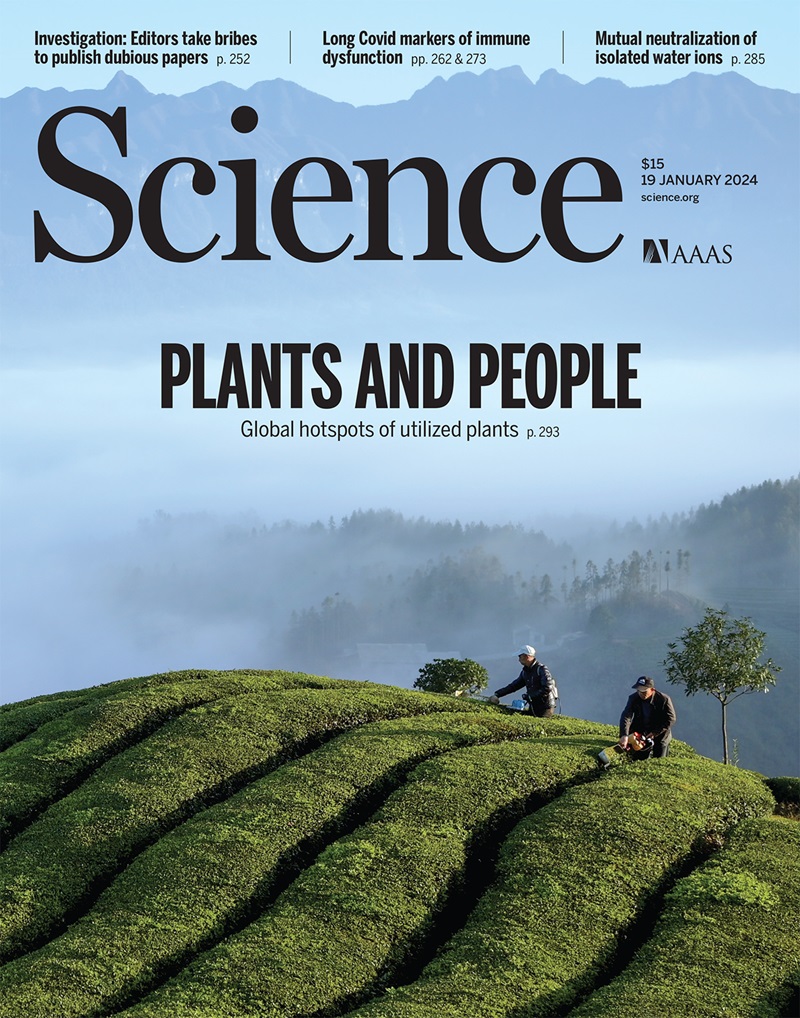Pseudogap and Fermi arc induced by Fermi surface nesting in a centrosymmetric skyrmion magnet.
IF 44.7
1区 综合性期刊
Q1 MULTIDISCIPLINARY SCIENCES
引用次数: 0
Abstract
Skyrmions in noncentrosymmetric materials are believed to occur due to the Dzyaloshinskii-Moriya interaction. By contrast, the skyrmion formation mechanism in centrosymmetric materials remains elusive. Here, we reveal the intrinsic electronic structure of the centrosymmetric GdRu2Si2 by selectively measuring magnetic domains using angle-resolved photoemission spectroscopy (ARPES). We found robust Fermi surface (FS) nesting, consistent with the magnetic modulation q-vector detected by the previous resonant x-ray scattering measurements. The pseudogap opens at the nested FS portions, which vary for different magnetic domains. The anomalous pseudogap disconnects the FS to generate Fermi arcs with twofold symmetry. These results indicate that the Ruderman-Kittel-Kasuya-Yosida (RKKY) interaction plays a decisive role in generating the screw spin modulation responsible for the skyrmion formation in GdRu2Si2. Furthermore, we demonstrate the flexible nature of magnetism in GdRu2Si2 by manipulating magnetic domains with magnetic field and temperature cyclings, providing potential future applications for data storage and processing devices.中心对称斯基子磁体中费米面嵌套引起的赝隙和费米弧。
在非中心对称的材料中,Skyrmions被认为是由Dzyaloshinskii-Moriya相互作用引起的。相比之下,中心对称材料中的粒子形成机制仍然难以捉摸。本文利用角分辨光发射光谱(ARPES)选择性测量磁畴,揭示了中心对称GdRu2Si2的本征电子结构。我们发现了稳健的费米表面(FS)嵌套,这与先前共振x射线散射测量检测到的磁调制q矢量一致。赝隙在嵌套的FS部分打开,其在不同的磁畴中有所不同。反常赝隙使FS断开,产生具有双重对称性的费米弧。这些结果表明Ruderman-Kittel-Kasuya-Yosida (RKKY)相互作用在GdRu2Si2中产生负责skyrmion形成的螺旋自旋调制中起决定性作用。此外,我们通过磁场和温度循环操纵磁畴,证明了GdRu2Si2中磁性的柔性性质,为数据存储和处理设备提供了潜在的未来应用。
本文章由计算机程序翻译,如有差异,请以英文原文为准。
求助全文
约1分钟内获得全文
求助全文
来源期刊

Science
综合性期刊-综合性期刊
CiteScore
61.10
自引率
0.90%
发文量
0
审稿时长
2.1 months
期刊介绍:
Science is a leading outlet for scientific news, commentary, and cutting-edge research. Through its print and online incarnations, Science reaches an estimated worldwide readership of more than one million. Science’s authorship is global too, and its articles consistently rank among the world's most cited research.
Science serves as a forum for discussion of important issues related to the advancement of science by publishing material on which a consensus has been reached as well as including the presentation of minority or conflicting points of view. Accordingly, all articles published in Science—including editorials, news and comment, and book reviews—are signed and reflect the individual views of the authors and not official points of view adopted by AAAS or the institutions with which the authors are affiliated.
Science seeks to publish those papers that are most influential in their fields or across fields and that will significantly advance scientific understanding. Selected papers should present novel and broadly important data, syntheses, or concepts. They should merit recognition by the wider scientific community and general public provided by publication in Science, beyond that provided by specialty journals. Science welcomes submissions from all fields of science and from any source. The editors are committed to the prompt evaluation and publication of submitted papers while upholding high standards that support reproducibility of published research. Science is published weekly; selected papers are published online ahead of print.
 求助内容:
求助内容: 应助结果提醒方式:
应助结果提醒方式:


